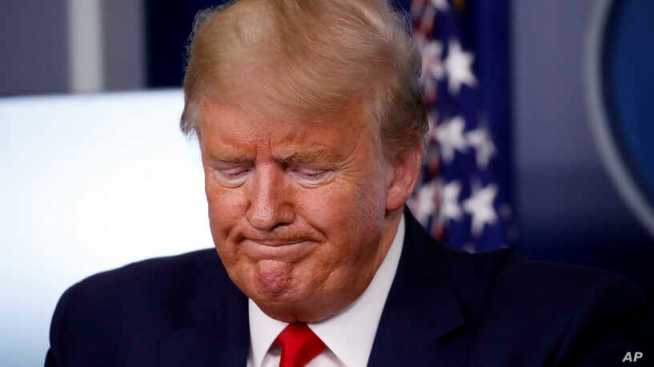Most Coronavirus Deaths in US Projected to Occur in Next Few Weeks

APTOPIX Virus Outbreak Trump
VOA News By Steve Herman
WHITE HOUSE – The United States should be prepared to endure 100,000 to 240,000 deaths from the #COVID-19 coronavirus over the next two months even if Americans continue to keep their distance from each other.
The peak number of deaths will come over the next two to three weeks, according to the White House coronavirus task force.
“Our country is in the midst of a great national trial unlike any we have faced before,” said U.S. President Donald Trump as the White House on Tuesday formally introduced its extended 30-day social-distancing guidelines based on statistical models.
“This is going to be one of the roughest two or three weeks we’ve ever had in our country,” Trump predicted.
For the most part, the two physicians on the podium with the president and Vice President Mike Pence administered the bitter medicine to the American public.
“This is a number we need to anticipate, but we don’t necessarily have to accept it as inevitable,” said Dr. Anthony Fauci, the director of the National Institute of Allergy and Infectious Diseases, of the anticipated 100,000-plus fatalities.

“There’s no magic bullet,” said Dr. Deborah Birx, an immunologist who is the response coordinator on the White House’s coronavirus task force. “There’s no magic vaccine or therapy,” just behaviors that can change the course of this viral pandemic.
More than 187,000 people in the United States have been diagnosed with the coronavirus. Total deaths in the country from the disease has exceeded 3,800 (about one-fourth of those in New York City) eclipsing the reported number in China and in excess of the number of lives lost initially in the terrorist attacks on the United States on Sept. 11, 2001.
The first COVID-19 case in the U.S. was reported in the Western state of Washington on Feb. 29.

The governor of New York, Andrew Cuomo, said the apex of his state’s battle against the disease is still 7 to 21 days out. During his daily briefing for the media, which aired live, for the most part, by the country’s three top cable TV news channels, Cuomo continued to express frustration with securing critical supplies for hospital intensive care units. He announced New York has put in an order from China for 17,000 ventilators at a cost of $25,000 each.
Cuomo said states and the federal government are all in competition to secure the breathing machines.
“It’s like being on eBay (an online auction site) with 50 other states bidding on a ventilator,” the governor said. “That’s literally what we’re doing.”
Forcing states to compete for critically needed supplies, “doesn’t make sense,” Cuomo added.
About 10,000 ventilators in the federal government’s inventory need to be held back for an anticipated surge in different parts of the country, Trump said.
“We have a reserve right now. It’s like oil reserves, but more valuable,” the president explained.
The chairman of the National Governors’ Association, Larry Hogan of Maryland, told CNN on Tuesday that his counterparts are pushing the federal government to coordinate purchases of scarce items for medical facilities so that states are not competing against each other.

Hours later, the mayor of New York City, Bill de Blasio said he needs an answer “right now” on a request that had been made to the White House for relief medical staff, including 1,000 nurses, 300 respiratory therapists and 150 physicians.
In the afternoon, before the briefing, Trump spoke on the phone with nine executives of top network service providers to thank the companies “for their tireless work to keep Americans connected during this time of social distancing,” said White House spokesman, Judd Deere. “The president thanked these leaders for not only rising to the increased demand but extending services to all Americans at no additional cost and for waiving bills and late fees for those experiencing financial hardship.”
In recent days, the president has adopted a more somber tone about the overall human toll that is going to be caused by the coronavirus in the country. Earlier he had brushed off the disease as nothing worse than the annual waves of influenza and stated, “the cure can’t be worse than the disease,” suggesting he would relax now-extended restrictions so the economy would not be more severely crippled.
The president has now pivoted from leaning toward the advice of some on his economic team who advocated loosening the social distancing restrictions to the public health officials – and members of his reelection team – with dire warnings.
Trump this week began publicly warning of the worst-case scenario of more than 2 million Americans dying of the virus if people returned to work and school prematurely.
On Tuesday, Trump also suggested a fourth phase spending bill by Congress that would total $2.2 trillion (a similar price tag that was on the third phase), but this legislation, he said, would focus solely on jobs and rebuilding the country’s infrastructure.
“We have a strong dollar. People want to invest in the United States” so “this would be a great time to borrow money at a zero interest rate” to fund fixing roads, highways, tunnels and bridges, Trump said.
Democratic congressional leaders have also started work on potential programs for a fourth phase bill, including infrastructure efforts that would put people to work, more money for unemployment benefits and more help for hospitals.
Republican leaders, including Senate Majority Leader Mitch McConnell have been cooler to the idea of more action now. McConnell said on the Hugh Hewitt radio show Tuesday, “Let’s see how things are going and respond accordingly.”

